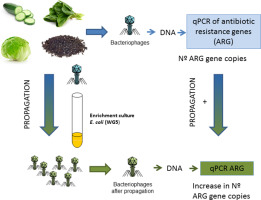Environment International ( IF 10.3 ) Pub Date : 2018-03-20 , DOI: 10.1016/j.envint.2018.03.019 Olatz Larrañaga , Maryury Brown-Jaque , Pablo Quirós , Clara Gómez-Gómez , Anicet R. Blanch , Lorena Rodríguez-Rubio , Maite Muniesa

|
Bacteriophages are ubiquitously distributed prokaryotic viruses that are more abundant than bacteria. As a consequence of their life cycle, phages can kidnap part of their host's genetic material, including antibiotic resistance genes (ARGs), which released phage particles transfer in a process called transduction. The spread of ARGs among pathogenic bacteria currently constitutes a serious global health problem. In this study, fresh vegetables (lettuce, spinach and cucumber), and cropland soil were screened by qPCR for ten ARGs (blaTEM, blaCTX-M-1 group, blaCTX-M-9 group, blaOXA-48, blaVIM, mecA, sul1, qnrA, qnrS and armA) in their viral DNA fraction. The presence of ARGs in the phage DNA was analyzed before and after propagation experiments in an Escherichia coli host strain to evaluate the ability of the phage particles to infect a host. ARGs were found in the phage DNA fraction of all matrices, although with heterogeneous values. ARG prevalence was significantly higher in lettuce and soil, and the most common overall were β-lactamases. After propagation experiments, an increase in ARG densities in phage particles was observed in samples of all four matrices, confirming that part of the isolated phage particles were infectious. This study reveals the abundance of free, replicative ARG-containing phage particles in vegetable matrices and cropland soil. The particles are proposed as vehicles for resistance transfer in these environments, where they can persist for a long time, with the possibility of generating new resistant bacterial strains. Ingestion of these mobile genetic elements may also favor the emergence of new resistances, a risk not previously considered.
中文翻译:

鲜切蔬菜和农业土壤中带有抗生素抗性基因的噬菌体颗粒
噬菌体是普遍分布的原核病毒,比细菌丰富。由于其生命周期,噬菌体可以绑架其宿主遗传物质的一部分,包括抗生素抗性基因(ARGs),该基因通过称为转导的过程释放噬菌体颗粒的转移。ARGs在致病细菌中的传播目前构成严重的全球健康问题。在这项研究中,通过qPCR筛选了新鲜蔬菜(生菜,菠菜和黄瓜)和农田土壤中的10种ARG(bla TEM,bla CTX-M-1组,bla CTX-M-9组,bla OXA-48,bla VIM,mecA,sul1,qnrA,qnrS和armA)在其病毒DNA片段中。在大肠杆菌中进行繁殖实验之前和之后,分析噬菌体DNA中ARG的存在宿主菌株以评估噬菌体颗粒感染宿主的能力。在所有基质的噬菌体DNA馏分中均发现了ARG,尽管其值不均一。生菜和土壤中的ARG发生率明显更高,最常见的总体是β-内酰胺酶。繁殖实验后,在所有四个基质的样品中均观察到噬菌体颗粒中ARG密度的增加,这证实了部分分离的噬菌体颗粒具有传染性。这项研究揭示了蔬菜基质和农田土壤中大量游离的,可复制的含有ARG的噬菌体颗粒。这些颗粒被提议作为这些环境中抗性转移的载体,在这些环境中它们可以长期存在,并可能产生新的抗性细菌菌株。









































 京公网安备 11010802027423号
京公网安备 11010802027423号